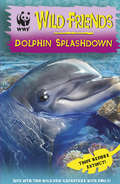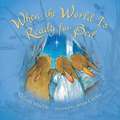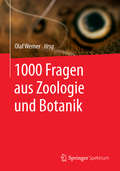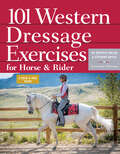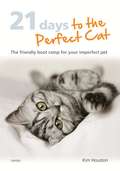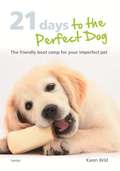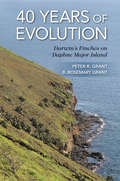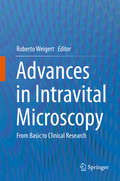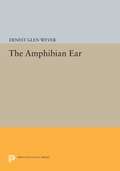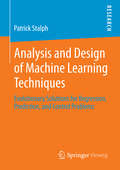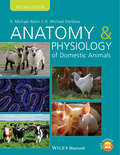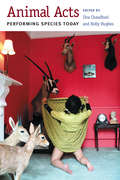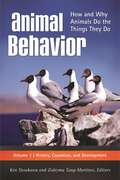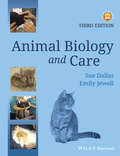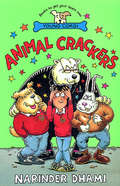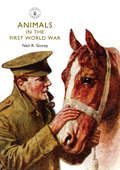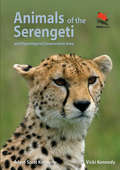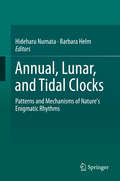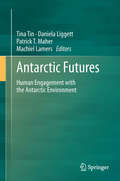- Table View
- List View
WWF Wild Friends: Book 7
by Linda Chapman Michelle MisraThe seventh title in this utterly adorable, totally WILD fiction series.Emily's fun-filled summer holiday in Florida is cut short when her mum gets an urgent call from the WWF. Soon they are exploring the Mexican coast, where Emily meets a new wild friend - baby dolphin Coral! But danger is just around the corner. Can Emily save Coral in time?
When the World Is Ready for Bed
by Gillian Shields Anna CurreyWhen the world / Is ready for bed / The sky grows dark / The sun glows red.The little flowers / Shut their eyes / The night birds sing / Their lullabiesTold with a gently rhyming text, this lovely story of the world falling asleep is just right for soothing babies and toddlers at bedtime.
1000 Fragen aus Zoologie und Botanik
by Olaf WernerDiese Studienhilfe dient Ihrer Selbstkontrolle und damit der Vorbereitung auf Prüfungen. Sie bietet Ihnen die Möglichkeit, sich mit den vielfältigen Fragen in Ruhe zu Hause auseinanderzusetzen und Ihr Wissen eigenständig zu überprüfen; oder Sie nutzen die Fragen als Anregungen, wenn Sie sich in Lerngruppen gegenseitig abfragen. Zusätzlich zu den rein zoologischen und botanischen Fragen sind außerdem einige aus den verwandten Bereichen Ökologie und Evolution enthalten, um den Prüfungsstoff umfassender abzudecken. Die 1000 Fragen sollen Ihnen helfen, sich in diesen vier Themengebieten zu vertiefen und sind nach den Fachgebieten geordnet. Sie finden zu den wichtigsten Themen Multiple-Choice-Fragen mit in der Regel kurzen Antworten, die Sie am Ende des Buches nachschlagen können. Die Fragen sind bewusst unterschiedlicher Natur und in unterschiedlichen Schwierigkeitsgraden. Wissensfragen erfordern ein Faktenwissen, das Sie sich in der Regel mit dem Durcharbeiten von Vorlesungen und Lehrbüchern problemlos aneignen werden. Daneben finden Sie Verständnisfragen, deren Beantwortung voraussetzt, dass Sie die Zusammenhänge in der Biologie insgesamt oder innerhalb biologischer Einzelthemen verstanden haben. Mit den 1000 Fragen sollten Sie auf ideale Weise Ihr Wissen überprüfen und Ihre Lücken erkennen können.
101 Western Dressage Exercises for Horse & Rider (Read & Ride)
by Jec Aristotle Ballou Stephanie BoylesThe exciting new discipline of Western Dressage allows riders of Western pleasure, work, or competitive horses to take advantage of the benefits of traditional dressage using Western tack and attire. This book, the first on the topic, has step-by-step instructions for the 101 key exercises.
21 Days To The Perfect Cat: The friendly boot camp for your imperfect pet
by Kim HoustonSimple, structured and effective, this 21-day course will prevent problem behaviour and, over subsequent days, encourage positive interaction, so that your cat continues to behave well. Exercises are given for each day in the training plan, with reinforcement of the previous day's learning scheduled in, as well as time for relaxation and play with your cat.The first section helps you to assess your key concerns so that you can tailor the programme to fit your needs, while a 'quick fix' section after the main training plan providing you with 50 speedy solutions to common problems, such as damaging furniture or unsociable behaviour towards strangers.Easy to fit in around your life, with this book you are just 21 training days away from the perfect cat.
21 Days To The Perfect Dog: The friendly boot camp for your imperfect pet
by Karen WildSimple, structured and effective, this 21-day course will prevent problem behaviour and, over subsequent days, encourage positive interaction, so that your dog continues to behave well. Exercises are given for each day in the training plan, with reinforcement of the previous day's learning scheduled in, as well as time for relaxation and play with your dog.The first section helps you to assess your key concerns so that you can tailor the programme to fit your needs, while a 'quick fix' section after the main training plan providing you with 50 speedy solutions to common problems, such as damaging furniture or unsociable behaviour towards strangers.Easy to fit in around your life, with this book you are just 21 training days away from the perfect dog.
40 Years of Evolution: Darwin's Finches on Daphne Major Island
by Peter R. Grant B. Rosemary GrantRenowned evolutionary biologists Peter and Rosemary Grant have produced landmark studies of the Galápagos finches first made famous by Charles Darwin. In How and Why Species Multiply, they offered a complete evolutionary history of Darwin's finches since their origin almost three million years ago. Now, in their richly illustrated new book, 40 Years of Evolution, the authors turn their attention to events taking place on a contemporary scale. By continuously tracking finch populations over a period of four decades, they uncover the causes and consequences of significant events leading to evolutionary changes in species.The authors used a vast and unparalleled range of ecological, behavioral, and genetic data--including song recordings, DNA analyses, and feeding and breeding behavior--to measure changes in finch populations on the small island of Daphne Major in the Galápagos archipelago. They find that natural selection happens repeatedly, that finches hybridize and exchange genes rarely, and that they compete for scarce food in times of drought, with the remarkable result that the finch populations today differ significantly in average beak size and shape from those of forty years ago. The authors' most spectacular discovery is the initiation and establishment of a new lineage that now behaves as a new species, differing from others in size, song, and other characteristics. The authors emphasize the immeasurable value of continuous long-term studies of natural populations and of critical opportunities for detecting and understanding rare but significant events.By following the fates of finches for several generations, 40 Years of Evolution offers unparalleled insights into ecological and evolutionary changes in natural environments.
40 Years of Evolution: Darwin's Finches on Daphne Major Island (PDF)
by Peter R. Grant B. Rosemary GrantRenowned evolutionary biologists Peter and Rosemary Grant have produced landmark studies of the Galápagos finches first made famous by Charles Darwin. In How and Why Species Multiply, they offered a complete evolutionary history of Darwin's finches since their origin almost three million years ago. Now, in their richly illustrated new book, 40 Years of Evolution, the authors turn their attention to events taking place on a contemporary scale. By continuously tracking finch populations over a period of four decades, they uncover the causes and consequences of significant events leading to evolutionary changes in species.The authors used a vast and unparalleled range of ecological, behavioral, and genetic data--including song recordings, DNA analyses, and feeding and breeding behavior--to measure changes in finch populations on the small island of Daphne Major in the Galápagos archipelago. They find that natural selection happens repeatedly, that finches hybridize and exchange genes rarely, and that they compete for scarce food in times of drought, with the remarkable result that the finch populations today differ significantly in average beak size and shape from those of forty years ago. The authors' most spectacular discovery is the initiation and establishment of a new lineage that now behaves as a new species, differing from others in size, song, and other characteristics. The authors emphasize the immeasurable value of continuous long-term studies of natural populations and of critical opportunities for detecting and understanding rare but significant events.By following the fates of finches for several generations, 40 Years of Evolution offers unparalleled insights into ecological and evolutionary changes in natural environments.
Advances in Intravital Microscopy: From Basic to Clinical Research
by Roberto WeigertThis is the first book entirely dedicated to Intravital Microscopy. It provides the reader with a broad overview of the main applications of Intravital Microscopy in various areas of the biomedical field. The book contains accurate descriptions of the state of the art methodologies used to image various organs at different level of resolution, ranging from whole tissue down to sub-cellular structures. Moreover, it is an extremely valuable guide to scientists that want to adopt this powerful technique and do not have experience with animal models and microscopy.
The Amazing World of Flyingfish
by Steve N. HowellIf you travel the open ocean anywhere in the tropics, you are very likely to see flyingfish. These beautifully colored "ocean butterflies" shoot out of the water and sail on majestic, winglike pectoral fins to escape from predators such as dolphins, swordfish, and tuna. Some can travel for more than six hundred feet per flight. Yet despite their prevalence in warm ocean waters and their vital role in the tropical food chain, surprisingly little is known about flyingfish—more than 60 species are said to exist, but nobody is sure of the number. This beautifully illustrated book presents flyingfish as you've never seen them before. It features more than 90 stunning color photos by renowned naturalist Steve Howell, as well as a concise and accessible text that explores the natural history of flyingfish, where they can be found, how and why they fly, what colors they are, what they eat and what eats them, and more.The ideal gift for fish lovers, seasoned travelers, and armchair naturalists alike, this first-of-its-kind book provides a rare and incomparable look at these spectacular marine creatures.Presents flyingfish like you’ve never seen them beforeFeatures more than 90 stunning color imagesExplores the natural history of flyingfish, where to see them, how they fly, and moreThe ideal gift book for fish lovers, ecotravelers, birders, and armchair naturalists
The Amphibian Ear
by Ernest Glen WeverProfessor Wever studies the structure of the ear and its functioning as a receptor of sounds in all amphibian species (139) for which living representatives could be obtained.Originally published in 1985.The Princeton Legacy Library uses the latest print-on-demand technology to again make available previously out-of-print books from the distinguished backlist of Princeton University Press. These editions preserve the original texts of these important books while presenting them in durable paperback and hardcover editions. The goal of the Princeton Legacy Library is to vastly increase access to the rich scholarly heritage found in the thousands of books published by Princeton University Press since its founding in 1905.
Analysis and Design of Machine Learning Techniques: Evolutionary Solutions for Regression, Prediction, and Control Problems
by Patrick StalphManipulating or grasping objects seems like a trivial task for humans, as these are motor skills of everyday life. Nevertheless, motor skills are not easy to learn for humans and this is also an active research topic in robotics. However, most solutions are optimized for industrial applications and, thus, few are plausible explanations for human learning. The fundamental challenge, that motivates Patrick Stalph, originates from the cognitive science: How do humans learn their motor skills? The author makes a connection between robotics and cognitive sciences by analyzing motor skill learning using implementations that could be found in the human brain – at least to some extent. Therefore three suitable machine learning algorithms are selected – algorithms that are plausible from a cognitive viewpoint and feasible for the roboticist. The power and scalability of those algorithms is evaluated in theoretical simulations and more realistic scenarios with the iCub humanoid robot. Convincing results confirm the applicability of the approach, while the biological plausibility is discussed in retrospect.
Anatomy and Physiology of Domestic Animals
by R. Michael Akers D. Michael DenbowAnatomy and Physiology of Domestic Animals, Second Edition offers a detailed introduction to the foundations of anatomy and physiology in a wide range of domestic species. Well illustrated throughout, the book provides in-depth information on the guiding principles of this key area of study for animal science students, fostering a thorough understanding of the complex make-up of domestic animals. This Second Edition includes access to supplementary material online, including images and tables available for download in PowerPoint, a test bank of questions for instructors, and self-study questions for students at www.wiley.com/go/akers/anatomy. Taking a logical systems-based approach, this new edition is fully updated and now provides more practical information, with descriptions of anatomic or physiological events in pets or domestic animals to demonstrate everyday applications. Offering greater depth of information than other books in this area, Anatomy and Physiology of Domestic Animals is an invaluable textbook for animal science students and professionals in this area.
Anatomy and Physiology of Domestic Animals
by R. Michael Akers D. Michael DenbowAnatomy and Physiology of Domestic Animals, Second Edition offers a detailed introduction to the foundations of anatomy and physiology in a wide range of domestic species. Well illustrated throughout, the book provides in-depth information on the guiding principles of this key area of study for animal science students, fostering a thorough understanding of the complex make-up of domestic animals. This Second Edition includes access to supplementary material online, including images and tables available for download in PowerPoint, a test bank of questions for instructors, and self-study questions for students at www.wiley.com/go/akers/anatomy. Taking a logical systems-based approach, this new edition is fully updated and now provides more practical information, with descriptions of anatomic or physiological events in pets or domestic animals to demonstrate everyday applications. Offering greater depth of information than other books in this area, Anatomy and Physiology of Domestic Animals is an invaluable textbook for animal science students and professionals in this area.
Animal Acts: Performing Species Today (Critical Performances)
by Una Chaudhuri Holly HughesWe all have an animal story—the pet we loved, the wild animal that captured our childhood imagination, the deer the neighbor hit while driving. While scientific breakthroughs in animal cognition, the effects of global climate change and dwindling animal habitats, and the exploding interdisciplinary field of animal studies have complicated things, such stories remain a part of how we tell the story of being human. Animal Acts collects eleven exciting, provocative, and moving stories by solo performers, accompanied by commentary that places the works in a broader context. Work by leading theater artists Holly Hughes, Rachel Rosenthal, Deke Weaver, Carmelita Tropicana, and others joins commentary by major scholars including Donna Haraway, Jane Desmond, Jill Dolan, and Nigel Rothfels. Una Chaudhuri’s introduction provides a vital foundation for understanding and appreciating the intersection of animal studies and performance. The anthology foregrounds questions of race, gender, sexuality, class, nation, and other issues central to the human project within the discourse of the “post human,” and will appeal to readers interested in solo performance, animal studies, gender studies, performance studies, and environmental studies.
Animal Behavior [3 volumes]: How and Why Animals Do the Things They Do [3 volumes]
by Alison M. Bell Andrew P. King Anna Dornhaus Anne Danielson-François Anthony C. Little Benedict C. Jones Bennett G. Galef Brett M. Gibson Brian Keane Bronwyn H. Bleakley Çağlar Akçay Carolynn L. Smith Catherine A. Marler Charles T. Snowdon Christopher D. Watkins Christopher Harshaw Christopher S. Evans David B. Mcdonald David Clark David Crews David F. Sherry David J. White Douglas W. Mock Geoffrey E. Hill George Uetz Guillermo Paz-Y-Miño-c James L. Gould Janis L. Dickinson Jason Low Jeffrey R. Alberts Ken Yasukawa Kenyon B. Mobley Laura Smale Lee Alan Dugatkin Lee C. Drickamer Lisa M. Debruine Mark E. Hauber Matthew J. Fuxjager Megan Hastings Hagenauer Meredith J. West Michael D. Beecher Michael J. Ryan Michelle Pellissier Scott Nancy G. Solomon Rachel A. Page Renée A. Duckworth S. Craig Roberts Sarah Jane Alger Sean P. Bradley Terry J. Ord Theodore Stankowich Walter D. Koenig Ximena E. Bernal Zenobia Lewis Zuleyma Tang-MartínezDiscover why animals do what they do, based on their genes, physiologies, cultures, traditions, survival and mating advantages, and evolutionary histories—and find out how studying behavior in the animal world helps us understand human behavior.The three volumes of Animal Behavior: How and Why Animals Do the Things They Do cover the breadth of the field, addressing causation, development, function, and evolution in a wide range of animals, from invertebrates to humans. Inspired by Nobel laureate Nikolaas Tinbergen's work, the first two volumes follow Tinbergen's four classic questions of animal behavior, while the third volume supplies integrated examples of Tinbergen's investigative process applied in specific cases.Written in an engaging, accessible manner ideal for college students as well as general audiences, this evidence-based collection provides a fascinating tour of animal behaviorists' findings, such as how animal communication can be truthful or deceitful, the deadly serious business behind clashes in the "battle of the sexes," and how documentation of animal behavior can lead to a deeper understanding of human behavior. Each chapter provides both historical background and information about current developments in animal behavior knowledge.
Animal Biology and Care
by Sue Dallas Emily JewellThe perfect study companion, Animal Biology and Care, 3rd Edition is specifically designed for students on animal care, animal nursing assistant and veterinary care assistant courses. This edition is fully updated with new course content, a refreshed design and colour illustrations throughout. Basic biological theory is introduced with diagrams for visual learners while photographs demonstrate the common practical procedures carried out by animal care assistants. Key features include: New content on exotic species, recognising the increasing number of these animals kept as pets. Extensive coverage of the Animal Welfare Act 2006 and recent advances in animal welfare. Written in line with course curricula, chapter summaries help you to remember key points and learning objectives. A companion website has interactive MCQs to help you test your knowledge. Divided into three main sections covering animal science and genetics, health and husbandry and nursing procedures, this book will help lay the foundations for a successful career in animal care and management!
Animal Biology and Care
by Sue Dallas Emily JewellThe perfect study companion, Animal Biology and Care, 3rd Edition is specifically designed for students on animal care, animal nursing assistant and veterinary care assistant courses. This edition is fully updated with new course content, a refreshed design and colour illustrations throughout. Basic biological theory is introduced with diagrams for visual learners while photographs demonstrate the common practical procedures carried out by animal care assistants. Key features include: New content on exotic species, recognising the increasing number of these animals kept as pets. Extensive coverage of the Animal Welfare Act 2006 and recent advances in animal welfare. Written in line with course curricula, chapter summaries help you to remember key points and learning objectives. A companion website has interactive MCQs to help you test your knowledge. Divided into three main sections covering animal science and genetics, health and husbandry and nursing procedures, this book will help lay the foundations for a successful career in animal care and management!
Animal Crackers
by Narinder DhamiWhen Sanjay gets a bump on his head from the school bully, he wakes up to find that everyone in the playground has turned into an animal! The headmaster's a polar bear and Sanjay's best friend is a sheepdog. Even the ambulance that comes to take him to hospital is driven by a gorilla and the paramedic is a penguin...Seeing his schoolmates in a new light gives Sanjay a clever idea about how to defeat the bully... Will Sanjay's wily plan work, or has the whole world gone animal crackers?
Animals in the First World War (Shire Library #790)
by Neil R. StoreyThe burden of the Great War was not shouldered by soldiers alone: the tasks, the camaraderie, the day-to-day life and the devastation were all shared with the animals that accompanied the forces abroad. The horses that took part in the last cavalry charges or hauled heavy guns are the most famous examples, but were far from alone: pigeons carried vital messages, dogs sniffed out wounded soldiers, camels were used as beasts of burden in the desert, and even ships' cats and baby orang-utans had their parts to play. From noted historian Neil R. Storey, this book looks at all the practical ways in which animals were essential to the war effort, but is equally interested in their roles as companions, mascots and morale boosters – on land, in the air and at sea. Neil R. Storey is a social and military historian specialising in the impact of war on society. He has written over twenty-five books, countless articles and has given lectures across the UK, including at the Imperial War Museum. He has acted as a consultant on a number of television documentaries and dramas.
Animals of the Serengeti: And Ngorongoro Conservation Area (PDF)
by Adam Scott Kennedy Vicki KennedyContaining 146 stunning color photos, Animals of the Serengeti is a remarkable look at the mammals and reptiles most likely to be encountered in the world-famous Serengeti National Park and Ngorongoro Crater. With an eye-catching layout, accessible text, and easy-to-use format, this detailed photographic guide includes 89 species of mammal and reptile. Useful "Top Tips"—shared by local Tanzanian guides that work in the region—provide visitors with insights into behavioral habits and how to locate specific animals. Filled with vivid anecdotes, Animals of the Serengeti will enable any safari traveler to identify the area's wildlife with ease.Covers the 89 species likely to be encountered in Tanzania’s Serengeti National Park and Ngorongoro Conservation Area Features male and female variationsAccessible text aimed at safari visitors of all levels
Annual, Lunar, and Tidal Clocks: Patterns and Mechanisms of Nature's Enigmatic Rhythms
by Hideharu Numata Barbara HelmThere is more to biological rhythms than circadian clocks. This book aims at promoting the exciting potential of a deeper understanding of circannual, circatidal, and circalunar clocks. It highlights new developments, summarizes existing knowledge, and integrates different perspectives with the tools and ideas of diverse fields of current biology.For predominantly pragmatic reasons, research in recent decades was mostly concerned with circadian clocks. Clocks on other timescales, however, have been largely neglected and therefore still appear "enigmatic". Thanks to the rapid development of methods in molecular biology as well as in ecology, we are now able to re-approach these clocks. Laboratories around the world are showing fresh interest and substantial progress is being made in many independent projects. The book's two sections address the moon-derived circatidal, circasemilunar, and lunar cycles on the one hand (10 chapters), and the sun-derived circannual cycles on the other (6 chapters). This work brings together authors with an expansive array of expertise and study systems, ranging from tidal cycles of marine invertebrates to annual cycles of birds and mammals, and from behavioral to genetic and epigenetic backgrounds. While great challenges remain to be mastered, the book aims at conveying the excitement of unraveling, broadly, the rhythms of life.
Ant and Bee and the ABC (Ant and Bee)
by Angela BannerThe much-loved classic series of Ant and Bee books is designed for shared reading fun! First published in 1950, Ant and Bee were in print for over 40 years. These new editions feature revised text and illustrations by original Ant and Bee creator Angela Banner. The adorably small format is perfect for little hands.
Ant and Bee and the Doctor (Ant and Bee)
by Angela BannerThe much-loved classic series of Ant and Bee books is designed for shared reading fun! First published in 1950, Ant and Bee were in print for over 40 years. These new editions feature revised text and illustrations by original Ant and Bee creator Angela Banner. The adorably small format is perfect for little hands.
Antarctic Futures: Human Engagement with the Antarctic Environment
by Tina Tin Daniela Liggett Patrick T Maher Machiel LamersAt the beginning of the 21st century, Antarctica is poised at the edge of a warmer and busier world. Leading Antarctic researchers examine the needs and challenges of Antarctic environmental management today and tomorrow. Through: (i) investigating the impacts of human activities on specific ecosystems and species, (ii) examining existing environmental management and monitoring practices in place in various regions and (iii) interrogating stakeholders, they address the following questions: What future will Business-As-Usual bring to the Antarctic environment? Will a Business-As-Usual future be compatible with the objectives set out under the Antarctic Treaty, especially its Protocol on Environmental Protection? What actions are necessary to bring about alternative futures for the next 50 years? This volume is an outcome of the International Polar Year (2007-2009) Oslo Science Conference (8-12, June, 2010).
